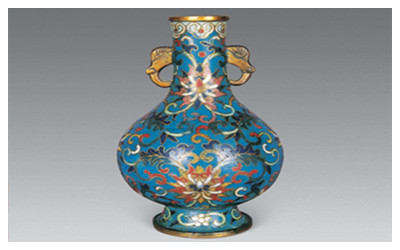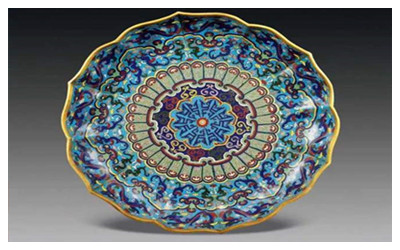
Cloisonné, also Jingtailan ( 景泰蓝), one of China's famous specialty product. There were this technology during the Spring and Autumn period. Up to the Ming Dynasty Jingtai years, it become the most beautiful and famous. So it is called "cloisonné."
The art of Jingtailan (Cloisonné) is a unique combination of sculpture, painting, porcelain making and copper-smithing that is said to have originated in
Beijing during the Yuan Dynasty (1271-1368). The oldest extant piece was made during the Yuan Dynasty, but Jingtailan underwent a major change during the Ming Dynasty when at about 1450 to 1456, a new blue pigment was discovered and gave Jingtailan its current name based on the Chinese word lan for blue. Ming Dynasty Jingtailan is also considered to be the most intricate. Nevertheless, Jingtailan reached its peak during the Qing Dynasty (1644-1911) due to great innovations in copper-melting techniques.

At present, Jingtailan is classified into two categories: Jingtailan and Flower-strip Jingtailan, each of which has several sub-varieties respectively.
The making of Jingtailan requires rather elaborate and complicated processes;base-hammering, copper-strip inlay, soldering, enamel-filling, enamel-firing, polishing and gilding. The products are featured by excellent quality. The skill and workmanship have been handed down from the Ming Dynasty. Since the founding of new China, quite a number of new varieties have been created. It enjoys a high reputation both at home and abroad with most of its products for export.
All the products are beautiful and elegant in molding, brilliant and dazzling in colors and splendid and graceful in design. It is a famous local handicraft in
Beijing region.
Jingtailan can be found on large objects such as vases and other large utensils and decorative items, as well as small items like earrings, bracelets, chopsticks or jars.

 Cloisonné, also Jingtailan ( 景泰蓝), one of China's famous specialty product. There were this technology during the Spring and Autumn period. Up to the Ming Dynasty Jingtai years, it become the most beautiful and famous. So it is called "cloisonné."
Cloisonné, also Jingtailan ( 景泰蓝), one of China's famous specialty product. There were this technology during the Spring and Autumn period. Up to the Ming Dynasty Jingtai years, it become the most beautiful and famous. So it is called "cloisonné." At present, Jingtailan is classified into two categories: Jingtailan and Flower-strip Jingtailan, each of which has several sub-varieties respectively.
At present, Jingtailan is classified into two categories: Jingtailan and Flower-strip Jingtailan, each of which has several sub-varieties respectively. Ask Questions ?
Ask Questions ?